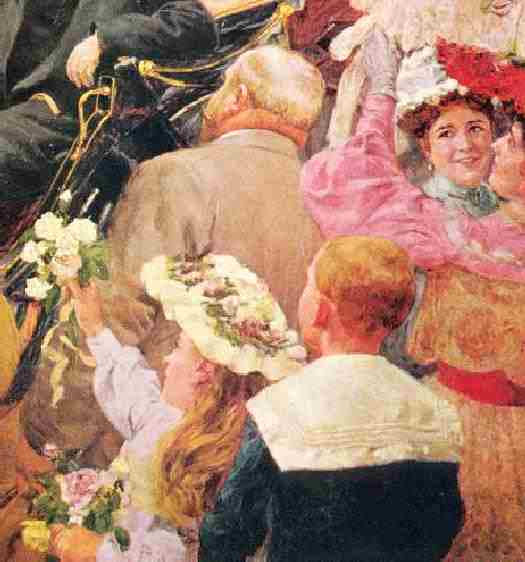
Figure 1.--This 1904 scene from a Vienna park shows a back of a boy wearing a blue sailor suit with a white square back flap. I'm not sure who the artist was. |

|
Austrian boys wore the common early 19th century styles of skeleton suits and tunics. I'm not sure just when they began wearing lederhosen, other than as rural dress, probably the mid- or late-19th century. About this time the sailor suit was imported and became quite popular. Few boys' garments proved more popular in Austria than the sailior suit. At the time the Austrian-Hungarian Empire had a small navy which it deployed in the Mediteranean. Popular 19th century boys' styles that do not seem to have been important in Austria were the kilt and Eton collar. Sailor suits continued to be worn, although they devlined in popularity after the NAZI Anschluss in 1937. Kneepants became ibnvreasingly common in the late 19th century, but were replaced with short pants after World War I (1914-18). Lederhosen were worn by many boys. Older boys might wear knickers, but shorts and long pants were also worn. Some boys wore smocks to school. After World War II (1939-45) fewer boys wore smocks to school. Lederhosen also became less common. Most boys wore shorts until long pants began to replace them in the 1960s.
Austrian boys wore the common early 19th century styles of skeleton suits and tunics. We notice boys at mid-century wearing jackets and long trousers with waustcoats and neck stocks rther like adults might wear. Age diferentyed clothing was much more common in the late 19ty century. I'm not sure just when they began wearing lederhosen, other than as rural dress, probably the mid- or late-19th century. About this time the sailor suit was imported and became quite popular. Few boys' garments proved more popular in Austria than the sailior suit. At the time the Austrian-Hungarian Empire had a small navy which it deployed in the Mediteranean. Popular 19th century boys' styles that do not seem to have been important in Austria were the kilt and Eton collar.
Our information on Austrian boys clothes during the 20th century is still limited, but we have begun to compile some information. Sailor suits and hats were very popular for Austrian boys in the early 20th century. White shirts were commonly worn, some with detachable collars. Most boys wore kneepants. Yonger boys wore a variety of tunic outfits with bloomer knickers. Older boys commonly wore Norfolk style jackets. Long stockings were very common, especially duting the cold winter weather. Clothing styles were very similar to Germany except that some younger boys seem to have worn fancier outfits. Sailor suits continued to be worn, although they gradually declined in popularity. Norfolk suits were popular in the 1920s, but by the late 20s modern looking single and double-breasted jackets were common. Boys began wearing more looking Kneepants were gnerally replaced with short pants after World War I (1914-18). Lederhosen were worn by many boys, especially in rural areas. Some boys had Alpine jackets which might be worn with lederhosen. . Older boys might wear knickers, but shorts and long pants were also worn. Some boys wore smocks to school. We note very little difference between Austrian and German clothes. Germany annexed Austria to the Reich with the Anchluss (1938). Kneesocks became increasingly popular, but younger boys commonly wore long stockings in cold weather. Boys began to more commonly wear colored shirts after the War. Conditions were very difficult in the immediate post-War era. Many children went barefoot, especially in rural areas. After the War, fewer boys wore smocks "Schüler Kittel" to school. Many boys commonly wore Lederhosen and other types of short pant. Lederhosen were especially common in rural areas. It was quite common, however, for city boys to dress up on Sunday with the Alpine-type jacket and lederhosen The girls also wore the folk dresses called drindles. A reader writes, " In Vienna during the 1950s, Austrian boys did not commonly swear caps, except in the winter. During the colder months many boys wore wool stocking caps. For Sunday many boys wore a traditional Austria suit ( Volkstrach ) with an Alpine-style cap. Even today one sometimes sees a boy or even a man during a party or on Sunday wearing " eine Lederhose " with his Austrian jacket. Many girls in the 1950s wore " Dirndlkleid "." Most Austrian boys wore shorts until long pants and jeans began to replace them in the 1960s.
Navigate the Boys' Historical Clothing Austrian pages:
[Return to the Main Austrian boys clothes page]
[Austrian art]
[Austrian choirs]
[Austrian movies]
[Austrian royalty]
[Austrian school uniforms]
[Austrian youth groups uniforms]
[Lederhosen]
Navigate the Boys' Historical Clothing Web Site:
[Introduction]
[Activities]
[Biographies]
[Chronology]
[Clothing styles]
[Countries]
[Topics]
[Bibliographies]
[Contributions]
[FAQs]
[Glossaries]
[Satellite sites]
[Tools]
[Boys' Clothing Home]
Navigate the Boys' Historical Clothing national pages:
[Return to the Main countries page]
[Australia]
[Austria]
[Belgium]
[England]
[France]
[Germany]
[Ireland]
[Italy]
[Japan]
[Korea]
[Mexico]
[New Zealand]
[Scotland]
[United States]
